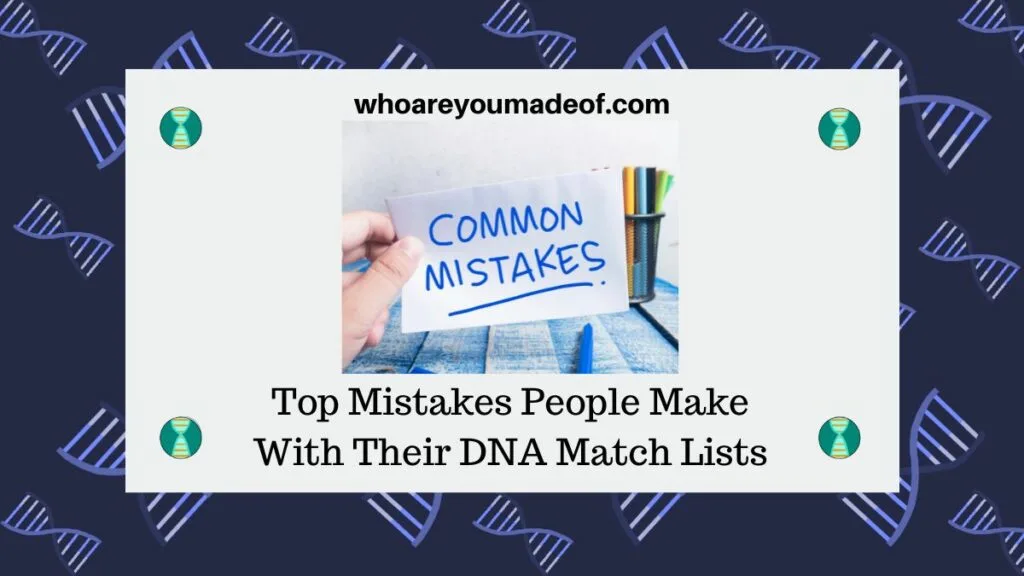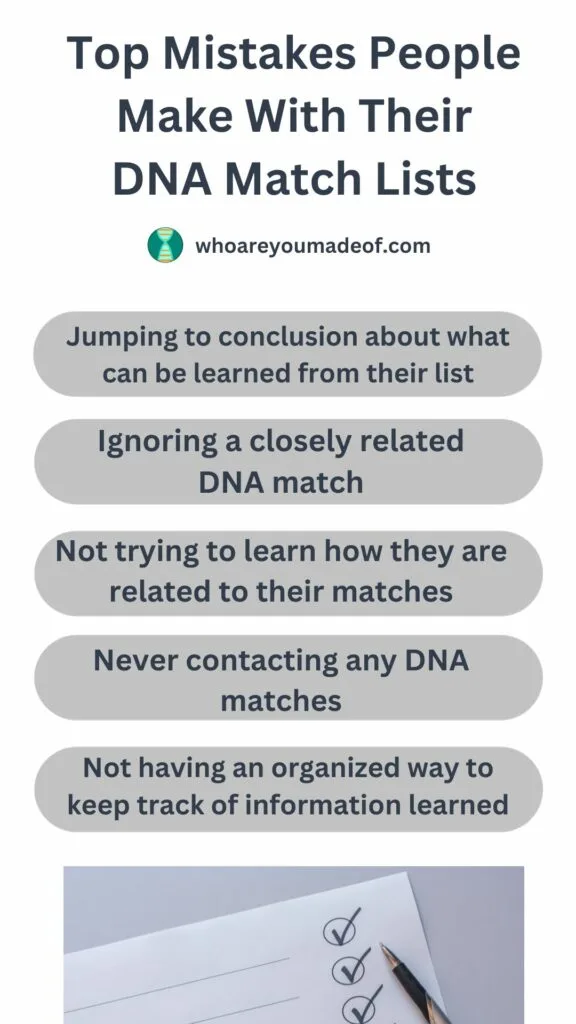Did you know that your DNA match list is the most useful aspect of your DNA results? In this post, learn about the most common mistakes people make with their DNA matches.

Since our DNA match lists are an incredible source of information, it's important to ensure we aren't making the following mistakes.
Jumping to conclusions about DNA matches
One common mistake that many people make when they first look at their DNA match list is "jumping to conclusions" about what the list is, or what they could potentially learn from it.
Do any of these statements sound like something that you would say?
- "I don't know who any of these people are!"
- "None of my DNA matches have a family tree!"
- "I'm adopted, how can I learn anything from my relatives if I don't have a tree to compare theirs with?"
- "I already have a family tree and there is nothing new for me to learn."
- "I see matches that I don't know. My DNA match list must be wrong."
- "This is too hard!"
While it's completely reasonable to feel the emotions behind any of those statements, completely ignoring your DNA match list and throwing your hands up in the air in frustration is going to make you feel like your DNA test was a waste of time and money.
Very recently, I was able to identify the biological grandparents of a distant DNA match who asked for my help using only her closest 20 or so DNA matches. It took me about two hours using a quick version of the Leeds method and my Ancestry account.
My relative, who had tested her DNA about four years ago, was absolutely shocked that her DNA matches could be so useful. She expressed to me that she "had been sitting on a goldmine of information" all of these years, yet had no idea.
Instead, why not spend some time learning about how to find out how your DNA matches are related to you, how to build a family tree, how DNA matches can help you build a family tree, and how to forget your story and follow the DNA.
Ignoring close matches, even if they don't make sense
Have you ever heard of the term "confirmation bias"? It means that we tend to view new information in a way that supports what we already believe. When we look at our DNA matches, we often have a preconceived notion of what we might find, and there is a chance we might ignore something (or someones!) who don't really line up with what we expect to learn about our family tree.
This phenomenon would be most accurately described as "cognitive dissonance". If we see a DNA match that doesn't fit in, we just assume that it's a mistake, or worse, ignore it completely.
By ignoring a DNA match (or a few DNA matches) that show up on our list, we miss out on the chance to learn everything that we can learn from our DNA. Will it mean discovering something previously unknown about your ancestry? Perhaps, but not always.
My strategy for approaching my DNA match list is to look at each match with fresh eyes and no assumptions. In this way, I can make sure that my family tree is "correct" and I can find exactly where each individual fits into my family lines. If I discover something that doesn't make sense, I know that I need to take a harder look at that part of my family tree.
Related: What to do if you get a surprise DNA match?
Article continues below image

Giving up too quickly on finding the common ancestor
Most people, when they first look at their DNA match list, only look at the names of their DNA matches. If they don't recognize any, they immediately assume that they won't be able to figure out the connection and they give up.
Don't be like most people!
Instead, make sure you looking for the following information about your DNA matches:
- Whether they have a family tree on their profile
- If you have uploaded your DNA somewhere else, check to see if they have, too (and maybe they have a tree on that other site)
- Which matches you share in common
- How much DNA you share and your estimated relationship (and read about shared centimorgans)
- For a complete list, check out the DNA match checklist
Not contacting any DNA matches
If you are actively researching your family tree using your DNA matches, which I highly recommend that you do, deciding to not to contact your DNA matches is a major lost opportunity.
When I first got interested in DNA testing, I tried to avoid contacting my DNA matches. I assumed that they wouldn't be interested in writing back to me, or that they would be bothered by the interruption.
While it's true that sometimes I don't get responses from my DNA matches, I have found that there is nothing to lose by reaching out to my newly discovered (albeit sometimes distant) relatives.
One of the most common reasons that I hear from my readers and others about why they don't contact their matches, or a particular group of matches, is because they don't have any family tree information listed on their profile or attached to their DNA results. The assumption is that since they have not bothered to list this information, they don't know much about their family history.
The obvious conclusion is that they wouldn't be much help to us anyway.
So, wow. Basically, we are being selfish by not contacting our DNA matches!
I've had all sorts of experiences communicating with my DNA relatives. Sometimes, I learn that they only know a little bit about their family tree and I'm able to help them fill in some blanks.
Other times, I am surprised about how knowledgeable they are about our ancestors. Occasionally, they have already done the hard work of determining how we are related and they inform me.
So basically, reach out. There's more to gain than to lose.
Not keeping DNA match research organized
If you are going through your DNA matches in a haphazard way without keeping track of what you are learning, you might find that you eventually forget what you've learned. It can take some time to figure out how someone is connected, and there are some "best practices" you can use to make sure that you never have to repeat any work that you've done.
Use the "notes" feature on your DNA match list
Take advantage of the "notes" feature of your DNA match list. All of the most popular DNA testing companies offer a way where you to make notes on your DNA matches.
No one else can see the notes you make (except other people who have access to your DNA match list).
I recommend making a note that goes something like this: "MRCA Hunter/Smith, paternal, Added to family tree" or "MRCA 5th great-grandparents Hunter/Smith, paternal, need to add to tree".
You can also include any additional information, like whether or not you have contacted them, etc.
If you use the notes feature, you'll be able to easily scroll through your list and find out what you already know. It will save you so much time!
You don't have a family tree?! Or you aren't adding your matches to it?
I've mentioned family trees sixteen times in this post. Yes, a family tree is so important that it is worth sixteen mentions.
If you have been spending your time trying to figure out how your matches are related, that's great! If you aren't adding them to your family tree (or you don't even have one) that's not so great.
I always build family trees on Ancestry. It's easy to do, completely free, and if you tested your DNA with Ancestry (as I have and recommend doing), you can attach your family tree to your DNA results and get extra features.
If you want access to documents, records, photographs, and family trees built by other members (a great resource!), you will need to have an Ancestry subscription. If you use the following sponsored link, you can get a two-week free trial to see how you like it: Ancestry Free Trial
By building a family tree and adding your DNA matches in with their family lines each time you discover a new connection, you will save yourself so much time in the future. (Read this post about building your tree "wide" for more details)
Advanced technique - chromosome mapping
You might have noticed that your DNA match list includes information about DNA segments shared with your matches. If you have been building a family tree, and you know how you are related to your DNA matches, you might be interested in an advanced technique called chromosome mapping.
It's not as hard as it sounds, but it does take a little more research.
I recommend using DNA Painter for chromosome mapping. You can easily create a visual "painting" using segment data obtained from a chromosome browser (most sites have them).
This can help you figure out exact which DNA segments you inherited from a particular ancestor, and how some of your more elusive DNA matches might be related to you.
Conclusion
I hope that you aren't making any of these mistakes with your DNA matches, but if you are, I hope that you learned how to correct your course going forward. If you have any questions about something that you read in this post, or if you would like to share your own experience with any of these "mistakes", I would love to hear from you in the discussion below.
Thanks for being here today!


Dennis Cox
Sunday 22nd of October 2023
Mercedes: One more item could be added to why individuals can get frustrated when dealing with DNA match lists: the use of "usernames" or an "alias" rather than using their given and actual surnames (maiden name for females). Using other than real names is understandable if one is concerned with privacy, in which case, it would be best if they chose to keep DNA results private so they would not appear on the match list of those of use using DNA matches to trace relatives and build family trees.